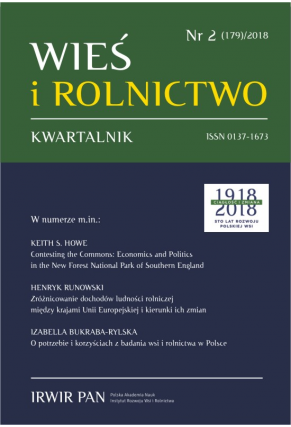Przeciwko dobru publicznemu. Wpływ ekonomii i polityki na Park Narodowy New Forest w południowej Anglii
DOI:
https://doi.org/10.53098/wir022018/05Słowa kluczowe:
parki narodowe, kapitał naturalny, konflikty interesów, Park Narodowy New Forest, AngliaAbstrakt
Artykuł jest studium przypadku unikalnego pod względem przyrodniczym obszaru w południowej Anglii, zwanego New Forest, przekształconego w park narodowy dopiero w 2005 r. Inspiracją do jego napisania była świadomość znaczenia parków narodowych dla ochrony środowiska w Polsce oraz przyciągające uwagę całego świata doniesienia o toczącym się konflikcie o wycinkę drzew w Puszczy Białowieskiej. Zarówno Park Narodowy New Forest, jak i Puszcza Białowieska to od lat obszary szczególnie ważne ze względu na ich szczególne walory przyrodnicze. Są miejscem rozwoju istniejących od stuleci wrażliwych ekosystemów, których dalsze przetrwanie jest obecnie zagrożone. Obszar New Forest jest od długiego czasu przedmiotem sporów dotyczących wykorzystania jego zasobów naturalnych, jak również uzasadnieniem dla powstawania wielu instytucji, których działalność ewoluowała w odpowiedzi na zmieniające się potrzeby gospodarcze i priorytety polityczne. Potrzeby ekonomiczne społeczeństwa zawsze prowadziły do konfliktów o postrzeganie tego, co stanowi możliwie najlepsze wykorzystanie ograniczonych zasobów. Czasami konflikt ten mogą wywołać argumenty dotyczące interesu narodowego; z kolei na drugiej szali kładzie się lokalne problemy i priorytety. Bez względu na skalę konfliktów interesów, muszą istnieć ramy instytucjonalne do ich rozwiązywania, jednocześnie nakierowane na ugodowe rozważenie decyzji mających na celu na ich ominięcie. Z historii Parku Narodowego New Forest mogą czerpać wnioski zarządzający innymi obszarami tego typu, także w Polsce. Artykuł przedstawia krótki rys historyczny i charakterystykę geograficzną obszaru New Forest, ze szczególnym uwzględnieniem opisu przeplatających się ze sobą nacisków ekonomicznych i zmian instytucjonalnych, sytuację dzisiejszą oraz przyszłe oczekiwania w świetle bieżących kierunków polityki. Autor konkluduje, że długofalowa międzynarodowa współpraca naukowa może dostarczyć nowej wiedzy, która przyczyni się do pielęgnowania tych unikalnych, cennych i niemożliwych do zastąpienia obszarów środowiska naturalnego.Bibliografia
Bateman I.J., Harwood A.R., Mace G.M., Watson R.T., Abson D.J., Andrews B., Binner A., Crowe A., Day B.H., Dugdale S., Fezzi C., Foden J., Hadley D., Haines-Young R., Hulme M., Kontoleon A., Lovett A.A., Munday P., Pascual U., Paterson J., Perino G., Sen A., Siriwardena G., van Soest D., Termansen M. (2013). Bringing ecosystem services into economic decision-making: Land use in the United Kingdom. Science, 341 (6141), 45–50. DOI: https://doi.org/10.1126/science.1234379
Chan K.M.A., Goldstein J., Satterfield T., Hannahs N., Kikiloi K., Naidoo R., Vadeboncoeur N., Woodside U. (2011). Cultural services and non-use values. In: P. K areiva, H. Tallis, T.H. Ricketts, G.C. Daily, S. Polasky (eds.), Natural Capital, Theory and Mapping Ecosystem Services (pp. 206–228). Oxford: Oxford University Press. DOI: https://doi.org/10.1093/acprof:oso/9780199588992.003.0012
Chatters C. (2009). Flowers of the Forest: Plants and people in the New Forest National Park. WILDGuides Ltd. with the support of English Nature. DOI: https://doi.org/10.1515/9780691237602
Cox J. (2013). A Review of Research into New Forest Commoning Livestock Enterprises. Jonathan Cox Associates, ecological consultancy.
Forestry Commission (1991). Report of the Working Party on Grazing in the New Forest (Illingworth Report). Department of Environment, Ministry of Agriculture, Fisheries and Food.
Forestry Commission (undated). Deer and their Management within the New Forest. Wildlife and Conservation Fact File. Lyndhurst: New Forest District, Education Section, Queen’s House.
Gould G. (personal communication, 2018). Doctoral research: Public Property and Private Greed: The politics of enclosure in the New Forest during the reign of George III, 1760–1820.
Hardin G. (1968). The tragedy of the commons. Science, 162 (3859), 1243–1248. DOI: https://doi.org/10.1126/science.162.3859.1243
Helm D. (2016). Natural Capital: Valuing the Planet. New Haven: Yale University Press. HM Government (2018). A Green Future: Our 25 Year Plan to Improve the Environment. London: Department for Environment, Food and Rural Affairs.
Ivey J. (2011). Census of the New Forest Commoners 2011: A report based on census data and the marking fee register from 1965 to 2010. JIRRA.
Kareiva P., Tallis H., Riceketts T.H., Daily G., Polansky S. (eds.) (2011). Natural Capital, Theory and Mapping Ecosystem Services. Oxford: Oxford University Press. DOI: https://doi.org/10.1093/acprof:oso/9780199588992.001.0001
Kenchington F.E. (1944). The Commoners’ New Forest: An outline of the Folk-History of the New Forest in the County of Southampton, its Peasant Pastoral Industry and its possibilities. London: Hutchinson and Co. Ltd.
Natural England (2010). Higher Level Stewardship Agreement. The Verderers of the New Forest AG 00300016 March 2010 – Feb 2020. February.
New Forest Association (2011). An Agenda for the Future of the New Forest. Policy Approved 1994 (Revised April 2005 and March 2011).
New Forest National Park (2010). Recreation Management Strategy 2010–2030. Lymington: New Forest National Park Authority.
Newton A.C. (ed.) (2010). Biodiversity in the New Forest. Totnes: Pisces Publications.
Nield S. (2005). Forest Law and the Verderers of the New Forest. Fordingbridge: The New Forest Research and Publication Trust.
Ostrom E. (1990). Governing the Commons: The Evolution of Institutions for Collective Action. Cambridge: Cambridge University Press. DOI: https://doi.org/10.1017/CBO9780511807763
Ostrom E. (2012). The Future of the Commons: Beyond Market Failure and Government Regulation. London: The Institute for Economic Affairs. DOI: https://doi.org/10.2139/ssrn.3916843
Pasmore A. (1977). Verderers of the New Forest: A History of the New Forest, 1877–1977. Kingsburg: Pioneer Publications Ltd.
Pasmore A. (1996). The New Forest Brand Book and A Guide to the Forest Atlases. Lyndhurst: The New Forest Research and Publication Trust.
Roberts P. (2016). Saving the New Forest: New Forest Association – The First 150 Years. New Forest Association.
Rodgers C.P., Straughton E.A., Winchester A.J.L., Pieraccini M. (2011). Contested Common Land: Environmental Governance Past and Present. London, Washington D.C.: Earth scan. DOI: https://doi.org/10.4324/9781849775632
Silcock P., Rayment M., Kieboom E., White A., Brunyee J. (2013). Valuing England’s National Parks. Final report for National Parks England. Broadway, Worcestershire: Cumulus Consultants Ltd.
Spencer J., Haworth R. (2005). Heathland on the Forestry Commission Estate in England. Survey Report, July.
Stagg D.J. (1974). The New Forest in Domesday Book. Hants Field Club Archaeological Society New Forest Section Report, 13, 20–24.
Stagg D.J. (1992). Silvicultural inclosure in the New Forest from 1850 to 1877. Proceedings of the Hampshire Field Club Archaeological Society, 48, 143–159.
Tubbs C.R. (1986). The New Forest. New Naturalist Series, 73, William Collins Sons and Co. Ltd. Revised and 2nd Edition (2001). Lyndhurst: New Forest Ninth Centenary Trust.
Verderers of the New Forest (undated, a). Commoners of the New Forest, Who Are They? What Do They do? Lyndhurst: The Queen’s House, http://www.verderers.org.uk/.
Verderers of the New Forest (undated, b). Verderers of the New Forest, Who Are They? What Do They do? Lyndhurst: The Queen’s House, http://www.verderers.org.uk/.
Wall D. (2014). The Commons in History: Culture, Conflict, and Ecology. Cambridge–London: The MIT Press. DOI: https://doi.org/10.7551/mitpress/9780262027212.001.0001
Wise J.R. (1895). The New Forest: Its History and Scenery. 5th Edition. London: Gibbings and Co. Ltd. DOI: https://doi.org/10.5962/bhl.title.32759
Websites:
Commoners Defence Association, http://www.nfcda.com/
Euronews, http://www.euronews.com/2016/01/18/poland-activists-call-for-bialowieza-forest-to-be-protected
New Forest Association (Friends of the New Forest), http://newforestassociation.org/
New Forest National Park Authority, http://www.newforestnpa.gov.uk/
New Forest Trust, https://www.newforesttrust.org.uk/
The Economist, https://www.economist.com/news/europe/21730041-preserving-bialowieza-forest-preserving-bialowieza
The Guardian, https://www.theguardian.com/environment/2017/jun/22/primeval-forest-bialowieza-must-lose-unesco-protection-says-poland
Verderers Court, http://www.verderers.org.uk/
Pobrania
Liczba pobrań artykułu
Strony
Jak cytować
Numer
Dział
Licencja
Prawa autorskie (c) 2018 Wieś i Rolnictwo

Utwór dostępny jest na licencji Creative Commons Uznanie autorstwa 4.0 Międzynarodowe.










